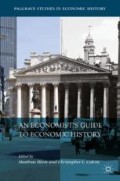Abstract
The management of the national debt does not correspond to the rules for management of the personal debt of individuals, households, or business enterprises. This chapter argues that economic history is of vital importance in elucidating this difference. Economic historians explore past episodes of unusually large expansions of sovereign debt to uncover the economic consequences when taxes are raised or not, and when the money supply is increased or not. This chapter uncovers the economics of sovereign debt by surveying academic debates on a selection of such historical events, including the Mississippi and South Sea bubbles and the sovereign default of Spain.
Access this chapter
Tax calculation will be finalised at checkout
Purchases are for personal use only
Notes
- 1.
- 2.
John Law was the son of a Scottish goldsmith banker, who witnessed the early stages of monetary and fiscal reform in London in the 1690s, when the Bank of England was founded. He spent his adult life advising other governments how to reform their finances. His efforts culminated in France, where the regent ruling that country in 1715 turned to Law for advice. His system, based on creating a royal bank and replacing government debt with shares in a company with monopoly rights over all foreign trade, most taxes and the mints, briefly enjoyed spectacular success. The system eventually collapsed and Law had to flee France for his life. See Murphy (1997) and Neal (2012).
- 3.
Alexander Hamilton was one of the architects of the US constitution, and was responsible for its financial policy for a large part of George Washington’s presidency.
- 4.
For the European State Finance Database, see: http://www.esfdb.org. For the Global Price and Income History Group, see: http://gpih.ucdavis.edu.
- 5.
The Drelichman-Voth data on Castile’s Fiscal Position, 1566–1596, are available to download at: https://economics.ubc.ca/faculty-and-staff/mauricio-drelichman/.
- 6.
See the contributions to Coffman and Neal (2013) for a discussion of the various commitment mechanisms used in the past to convince public creditors that sovereign debt constituted an accessible, safe and liquid investment vehicle.
Reading List
Alvarez-Nogal, Carlos, and Christophe Chamley. 2014. Debt Policy under Constraints: Philip II, the Cortes, and Genoese Bankers. Economic History Review 67 (1): 192–213.
———. 2016. Duplication without Constraints: Response. Economic History Review 69 (3): 1007–1013.
Antipa, Pamfili. 2016. How Fiscal Policy Affects Prices: Britain’s First Experience with Paper Money. Journal of Economic History 76 (4): 1044–1077.
Coffman, D’Maris, and Larry Neal, eds. 2013. Questioning Credible Commitment: Perspectives on the Rise of Financial Capitalism. Cambridge: Cambridge University Press.
Drelichman, Mauricio, and Hans-Joachim Voth. 2014. Lending to the Borrower from Hell: Debt, Taxes, and Default in the Age of Philip II. Princeton, NJ: Princeton University Press.
———. 2016. Duplication without Constraints: Alvarez-Nogal and Chamley’s Analysis of Debt Policy under Philip II. Economic History Review 69 (3): 999–1006.
Esteves, Rui, and Coskun Tunçer. 2016. Feeling the Blues: Moral Hazard and Debt Dilution in Eurobonds before 1914. Journal of International Money and Finance 65: 46–68.
Hotson, Anthony C. 2017. Respectable Banking: The Search for Stability in London’s Money and Credit Markets since 1695. Cambridge: Cambridge University Press.
Marichal, Carlos. 1989. A Century of Debt Crises in Latin America: From Independence to the Great Depression, 1820–1930. Princeton, NJ: Princeton University Press.
Murphy, Antoin E. 1986. Richard Cantillon, Entrepreneur and Economist. New York, NY: Oxford University Press.
———. 1997. John Law Economist Theorist and Policy-Maker. Oxford: Oxford University Press.
———. 2018. John Law: A Twenty-First Century Banker in the Eighteenth Century? In Financial Innovation and Resilience: A Comparative Perspective on the Public Banks of Naples (1462–1808), ed. L. Costabile and L. Neal. Basingstoke: Palgrave Macmillan.
Murphy, Anne L. 2009. The Origin of English Financial Markets: Investment and Speculation before the South Sea Bubble. Cambridge: Cambridge University Press.
Neal, Larry. 1990. The Rise of Financial Capitalism: International Capital Markets in the Age of Reason. New York, NY: Cambridge University Press.
———. 2000. How It All Began: The Monetary and Financial Architecture of Europe from 1648 to 1815. Financial History Review 72 (2): 117–140.
———. 2012. ‘I Am Not Master of Events’: The Speculations of John Law and Lord Londonderry in the Mississippi and South Sea Bubbles. New Haven, CT: Yale University Press.
———. 2015. A Concise History of International Finance: From Babylon to Bernanke. Cambridge: Cambridge University Press.
Tunçer, Ali Coskun. 2015. Sovereign Debt and International Financial Control: The Middle East and the Balkans, 1870–1914. Basingstoke: Palgrave Macmillan.
Velde, François. 2009. John Law’s System and Its Aftermath, 1718–1725. In The Origins and Development of Financial Markets and Institutions: From the Seventeenth Century to the Present, ed. J. Atack and L. Neal. Cambridge: Cambridge University Press.
Author information
Authors and Affiliations
Editor information
Editors and Affiliations
Rights and permissions
Copyright information
© 2018 The Author(s)
About this chapter
Cite this chapter
Neal, L.D. (2018). Sovereign Debt and State Financing. In: Blum, M., Colvin, C. (eds) An Economist’s Guide to Economic History. Palgrave Studies in Economic History. Palgrave Macmillan, Cham. https://doi.org/10.1007/978-3-319-96568-0_13
Download citation
DOI: https://doi.org/10.1007/978-3-319-96568-0_13
Published:
Publisher Name: Palgrave Macmillan, Cham
Print ISBN: 978-3-319-96567-3
Online ISBN: 978-3-319-96568-0
eBook Packages: Economics and FinanceEconomics and Finance (R0)

